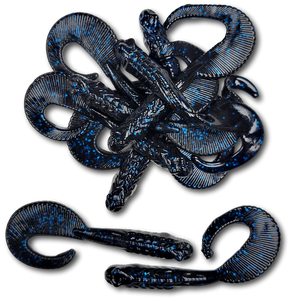Grubs are a time-tested favorite among anglers due to their simplicity and effectiveness. These soft plastics feature a compact, streamlined body with a curly or paddle tail that creates irresistible movement in the water. Their design allows for a wide range of rigging and retrieval techniques, making them one of the most adaptable baits available.
The key to a grub’s success is its action. The tail kicks and vibrates as it moves through the water, mimicking small prey like baitfish, insects, or even crustaceans. Grubs are especially effective in situations where fish are feeding on smaller forage, and they excel in both freshwater and saltwater environments.
Grubs are incredibly versatile and can be rigged to target fish at any depth or in any type of cover. Here are the most popular ways to fish them:
Jig Head Rig: The classic way to fish a grub is on a jig head. This setup is perfect for casting, vertical jigging, or even slow trolling. Select a jig head weight that matches the depth and current you’re fishing, and retrieve the grub at a steady pace. The tail’s action will do most of the work, imitating a fleeing baitfish or swimming insect.
Spinner Jig Combo: Pairing a grub with a jig spinner arm creates a spinnerbait-like presentation that excels in stained water or low-light conditions. The added flash and vibration draw fish from a distance, while the grub’s tail seals the deal.
Swimbait Rig: Larger grubs can be rigged on swimbait hooks to target bigger fish like bass or redfish. This setup is ideal for fishing shallow flats, grass lines, or rocky points.
Carolina Rig: For deeper presentations, a Carolina rig keeps the grub near the bottom while allowing it to move naturally with the current. This is especially effective for walleye or bass holding on ledges and drop-offs.
Weightless Rig: A small grub rigged weightless can be deadly in shallow water, especially when targeting crappie or panfish near vegetation or docks.
Grubs also excel as trailers on spinnerbaits, bladed jigs, or swim jigs, adding action and bulk to these moving baits.
Grubs are effective year-round, but their versatility makes them particularly valuable in specific conditions:
- Spring: Grubs are perfect for targeting bass, crappie, and walleye as they move into shallow water to spawn. Fish them on a light jig head near brush piles, rocks, or vegetation.
- Summer: In warmer months, grubs are ideal for targeting fish holding deeper. Use heavier jig heads to fish drop-offs, ledges, or submerged structure. Slow trolling with grubs can also be highly productive for walleye.
- Fall: As fish feed heavily before winter, grubs are an excellent bait for mimicking baitfish. Cast and retrieve grubs near points, riprap, or shallow flats where fish are actively chasing prey.
- Winter: Grubs remain effective during colder months, especially for vertical jigging through schools of walleye or crappie. Use smaller grubs and slow down your presentation to match the lethargy of the fish.
Grubs perform well in lakes, rivers, reservoirs, and even coastal waters. Their versatility makes them suitable for any environment, but they are particularly effective in areas with structure, such as rocks, brush, or submerged vegetation.
Best Colors and Sizes for Grubs
Choosing the right color and size for your grub can make all the difference.
- In clear water, natural colors like white, silver, or watermelon green work best to mimic small baitfish.
- In stained or murky water, brighter colors like chartreuse, orange, or pink help fish locate the bait.
- For night fishing or low-light conditions, darker colors like black or junebug provide a strong silhouette.
Grubs typically range in size from 1 inch to 6 inches. Smaller grubs (1-3 inches) are ideal for crappie, bluegill, or trout, while larger grubs (4-6 inches) are better for targeting bass, walleye, or even saltwater species like redfish or speckled trout.
Why Grubs Are So Effective
Grubs excel because of their simplicity and versatility. Their compact profile and natural swimming action mimic a wide range of prey, appealing to a broad spectrum of fish. The constant tail vibration creates water displacement, making the bait detectable even in low-visibility conditions.
Grubs are also forgiving to fish. Whether you’re a beginner or a seasoned angler, their easy-to-use design ensures success across skill levels. Simply cast, retrieve, or jig the grub to trigger bites, letting the action of the bait do the hard work.
Tips for Fishing Grubs
When fishing grubs, adjust your retrieve speed to match the conditions and the mood of the fish. In warmer water or active feeding times, a faster retrieve can mimic a fleeing baitfish. In colder water or tough conditions, slow down and allow the bait to glide near the bottom.
Using lighter line (4-8 lb fluorocarbon or monofilament) helps maintain a natural presentation, especially in clear water. If you’re targeting larger fish or fishing in heavy cover, consider stepping up to heavier tackle.
Experiment with jig head weights and retrieve styles to find the sweet spot for your fishing conditions. Lifting and dropping the bait off the bottom, known as "hopping," is a proven tactic for walleye and bass.
Soft plastic grubs are the ultimate utility bait. Their simple yet effective design makes them a go-to choice for anglers targeting everything from bass to crappie to walleye. Whether you’re jigging for walleye, casting for bass, or trolling for crappie, grubs will get the job done. Stock up on a variety of colors and sizes, and be prepared for consistent results on your next fishing trip.
Qwik Catches!













